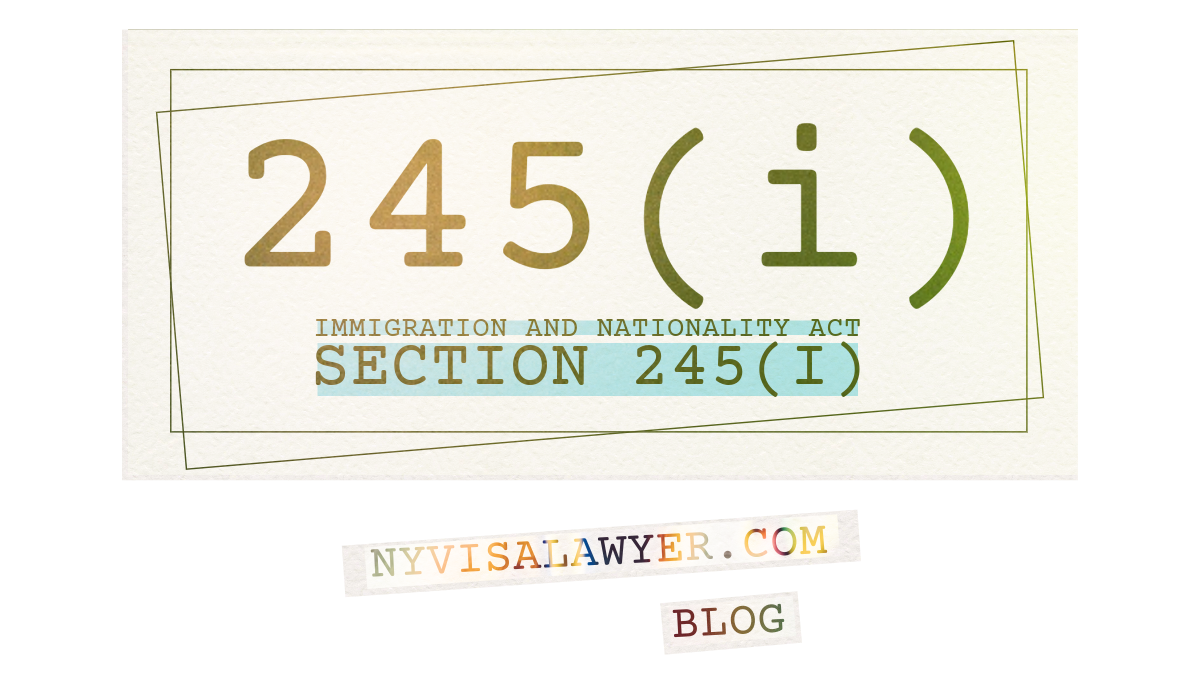WHAT IS SECTION 245(I) OF THE IMMIGRATION AND NATIONALITY ACT? Section 245(i) of the Immigration and Nationality Act (INA) allows certain noncitizens physically present in the United States to adjust status to a lawful permanent resident despite being ineligible to adjust status under INA 245(a) because they entered the United States without inspection, violated their nonimmigrant status, were employed in the United States without authorization, or are otherwise barred from adjustment by INA 245(c). Those grandfathered under INA 245(i) can waive their immigration violation(s) and adjust status upon payment of a $1,000 fee, which essentially serves as a fine. WHO IS GRANDFATHERED UNDER INA 245(I)? Immigrants who are the beneficiary of a labor certification or family-based visa petition (or less common Immigrant Petition by Alien Entrepreneur (Form I-526))that was filed on or before April 30, 2001, would be grandfathered under INA 245(i). The labor certification or petition must have been approvable when filed, even if it was never approved. Approvable when filed means that it was properly filed, meritorious in fact; and Non-frivolous. INA 245(i) also grandfathered derivative beneficiaries of theses labor certifications and visa petitions. The basis of a grandfathered individual’s eventual adjustment, however, is not restricted to the application or petition filed to preserve adjustment eligibility. The grandfathered individual’s application for adjustment of status may be based on any adjustment provision available to the individual at the time of adjustment and usually won’t be based on the grandfathering petition or labor cert. For example, a qualifying Form ETA-750 filed on or before Jan. 14, 1998, preserves the individual’s eligibility to adjust status after that date. However, the filed ETA-750 does not commit that individual to adjustment on the basis of an employment based petition. If, after Jan. 14, 1998, the individual was named as beneficiary in a family based petition or won an immigrant visa in the diversity lottery, they may adjust status on the new basis. (The immigrant visa won in the diversity lottery will not grandfather an individual, but may be used as a basis of adjustment by an individual who is already grandfathered under section 245(i)). HISTORY, AMENDMENTS, AND EXTENSIONS In 1997, 245(i) was extended and revised. Qualified applicants no longer had to submit their application for adjustment of status by October 1, 1997. Rather, an immigrant visa petition or labor certification application had to be filed on the principal applicant’s behalf on or before a newly established deadline of January 14, 1998. However, as long as this occurred no earlier than October 1, 1994, the application for adjustment of status itself (for the principal applicant or eligible spouse and children) could be filed at any time; even years after the filing deadline. In 2000, 245(i) was extended and revised again for the last time. The Legal Immigration Family Equity (LIFE) Act Amendments of 2000 set a new deadline of April 30, 2001, for the filing of the required immigrant visa petition or labor certification application on behalf of the principal applicant. As long as the filing deadline was met, the application for adjustment of status could be filed at any time. The 2000 revision of 245(i) also required that, if the immigrant visa petition or labor certification application was filed after January 14, 1998, the principal applicant had to have been physically present in the United States on December 21, 2000 (the date of enactment of the LIFE Act Amendments). CURRENT ELIGIBILITY REQUIREMENTS FOR 245(I) Under current law, an undocumented immigrant can apply for LPR status under Section 245(i) if he or she meets the following conditions: To file for adjustment under INA 245(i) you must file a Supplement A to Form I-485 along with all the forms and documents required for adjustment pursuant to whatever grounds you are adjusting status under. WILL IT BE EXTENDED AGAIN? Some people anticipate this section being extended one day as a measure to help resolve the current immigration problems. Congress retains the authority to either extend the filing deadline or eliminate it. If Congress acts on this issue, it is estimated that as many as 2.3 million unauthorized immigrants living in the United States may be able to seek a green card through sponsorship by a spouse, other family member, or employer. As we get further and further away from 2001 it seems less and less likely though. Though, May 13, 2021, Senator Catherine Cortez Masto (D-Nevada) reintroduced the Fairness for Immigrant Families Act (S.1638) that, among other things, would extend the filing deadline for §245(i) from April 30, 2001, to five years following the enactment of the Fairness for Immigrant Families Act. The information below is taken directly from the USCIS Policy Manual, Volume 7, Chapter 2: Qualifying Immigrant Visa Petition or Labor Certification Application A qualifying immigrant visa petition or permanent labor certification application is defined as a petition or application that was both “properly filed” on or before April 30, 2001 and “approvable when filed.” A qualifying immigrant visa petition may include any of the following forms: A qualifying permanent labor certification application refers to an Application for Alien Labor Certification (ETA Form 750). 1. Properly Filed Qualifying Immigrant Visa Petition For purposes of INA 245(i), an immigrant visa petition is considered properly filed if: A petition received with either an illegible or missing postmark is timely filed if INS physically received the petition by May 3, 2001, and stamped it with a “Filed Prior to 245(i) Sunset” stamp. Qualifying Permanent Labor Certification Application A permanent labor certification application is properly filed if it was filed on or before April 30, 2001 and accepted for processing according to the regulations of the Secretary of the U.S. Department of Labor (DOL) that existed at the time of filing. During the INA 245(i) qualifying time period and under authority delegated by DOL, permanent labor certification applications were generally filed directly with the state workforce agency (SWA) (such as a State Employment Service Agency) in the state where the offered job was located. The SWA indicated the filing date or receipt … Read more



